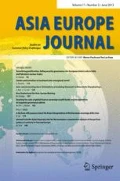Abstract
This article contributes to a bidirectional Asia–Europe comparative analysis of peace processes by exploring what experiences, both failures and successes, can the Basque peace process learn from the many interesting peace initiatives that Southeast Asia has seen in recent years, above all in Mindanao, Aceh, Southern Thailand and Burma. Although there are substantial differences between the Basque conflict and the Asian cases, it might be useful for the Basque case to look beyond the cases with which it traditionally has been compared to, such as Quebec, Northern Ireland or South Africa.
Similar content being viewed by others
Notes
In Spanish language, the term Basque Country often refers to the Basque Autonomous Community, also known as Euskadi.
In 2006, the European Parliament approved a resolution on the conflict and Primer Minister Zapatero tacitly led the door open for a future role of UN, which provoked an angry reaction of some conservative media. During the 1990s, the Carter Center and the Swiss government tried to explore some contacts between the parties. During the 1980s, several talks were held in Algiers between different socialist Governments and ETA. In 2005 and 2006, ETA and the Government met in Norway, Switzerland and Turkey.
The term "Moro" was coined by the Spaniards in reference to the Muslim population of Mindanao. Although for decades it had negative connotations, from the 1970s onwards the armed organizations (such as the MNLF and the MILF) adopted the term to define themselves. Today the Bangsamoro concept (literally, Moro nation) refers to the 13 ethno-linguistic groups of Mindanao, the archipelago of Sulu and Palawan, united mainly by Islamic beliefs, the historical background of the sultanates of Sulu or Maguindanao and shared historical experiences like the anti-colonial armed resistance.
The Moro population does not make up more than 20% of the population in Mindanao and the few regions in which they are the majority are quite clearly the most impoverished of the country.
The Lumads are the original or indigenous peoples, largely animistic, and have maintained a traditional way of life. The fact that the Lumads, and are very inferior in number to Muslims and Christians, has meant that they have never had access to the structures of power nor have they had pre-eminent positions in the revolutionary struggle, which has relegated them to the status of observers and victims in the conflict rather than active and decisive participants.
References
Cagoco-Guiam R (2004) Mindanao: conflicting agendas, stumbling blocks, and prospects toward sustainable peace.. In: Heijmans A, Simmonds N, Van de Veen H (eds) Searching for peace in Asia Pacific. An overview of conflict prevention and peacebuilding activities. Lynne Rienner, London
Espiau G (2006) The Basque conflict. New ideas and prospects for peace, USIP, Special Report 161
Fisas V (2007) Anuario 2007 de procesos de paz. Icaria, Barcelona
GARA (2007) 2005–2007 Proceso de negociación. En busca de un acuerdo político resolutivo; http://www.gara.net/agiriak/laburtua_web.pdf
International Crisis Group (2003a) Aceh: a fragile Peace, Asia Report, n° 47, http://www.crisisgroup.org/home/index.cfm?id=1396&l=1
International Crisis Group (2003b) Myanmar backgrounder: ethnic minority politics, Asia Report, n°52, http://www.crisisgroup.org/home/index.cfm?id=1528&l=1
International Crisis Group (2005) Southern Thailand: insurgency, Not Jihad, Asia Report, n°98, http://www.crisisgroup.org/home/index.cfm?id=3436&l=1
Kramer G (2004) Burma/Myanmar: military rule and ethnic conflict. In: Heijmans A, Simmonds N, Van de Veen H (eds) Searching for peace in Asia Pacific. An overview of conflict prevention and peacebuilding activities. Lynne Rienner, London
Linstroth J (2006) the annual meeting of the International Studies Association, Town & Country Resort and Convention Center, San Diego, California, March 22-25, 2006. Toward Basque peace: the Basque conflict and the prospects of peace with ETA
School for a Culture of Peace (2007) Alert 2007! Report on armed conflicts, human rights and peace building. Icaria, Barcelona
Author information
Authors and Affiliations
Corresponding author
Additional information
The author is particularly grateful to Vicenç Fisas, Director of the School for a Culture of Peace at the Autonomous University of Barcelona for his very valuable comments and suggestions, both based on his long standing experience studying the Basque Conflict. Most findings are based on a field research work conducted between August and December 2006 in Indonesia (Aceh), Philippines (Mindanao and Manila), Myanmar (Yangon, Shan, Karen and Mon states, as well as the border regions with Thailand in which are based some of the armed groups and the pro-democracy organisations) and Thailand (four southern provinces and Bangkok), as well as in Malaysia (Kuala Lumpur and the northern provinces, contiguous to Thailand) and Singapore (where are based some of the most well known research centres on South East Asian issues). The field research work included the visit to areas of conflict, the collaboration with local research institutions or the conduction of around 350 interviews to politicians, scholars, representatives of the civil society and the international community, as well as the leaders of some of the armed groups of the region. A previous field research was conducted in Aceh in November and December 2005
Rights and permissions
About this article
Cite this article
Urgell, J. What can the Basque peace process learn from Southeast Asia?. AEJ 6, 31–42 (2008). https://doi.org/10.1007/s10308-007-0158-7
Published:
Issue Date:
DOI: https://doi.org/10.1007/s10308-007-0158-7




